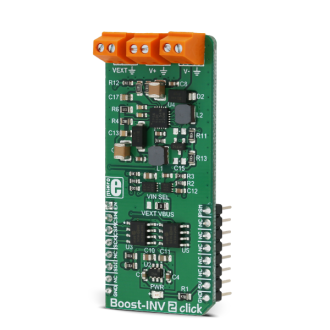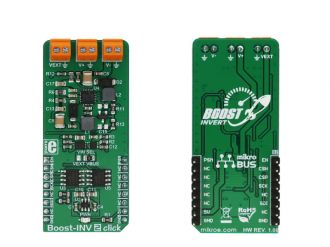
We strongly encourage users to use Package manager for sharing their code on Libstock website, because it boosts your efficiency and leaves the end user with no room for error. [more info]

Rating:
Author: MIKROE
Last Updated: 2018-08-14
Package Version: 1.0.0.0
mikroSDK Library: 1.0.0.0
Category: Boost
Downloaded: 5704 times
Not followed.
License: MIT license
Boost-INV 2 click is a very useful DC/DC voltage converter device, as can output both positive and negative voltage, boosted up to 15V and inverted to -15V, from a single fixed voltage input.
Do you want to subscribe in order to receive notifications regarding "Boost-INV 2 click" changes.
Do you want to unsubscribe in order to stop receiving notifications regarding "Boost-INV 2 click" changes.
Do you want to report abuse regarding "Boost-INV 2 click".


Library Description
The library initializes and defines SPI drivers along with the driver that gives an option to set desired positive and negative output voltages.
Key functions:
void boostinv2_enable() - Functions for enable chip.void boostinv2_setPositiveVoltage( uint16_t voltage ) - Functions for set positive output voltage.void boostinv2_setNegativeVoltage( uint16_t voltage ) - Functions for set negative output voltage.Example description
The application is composed of three sections:
void applicationTask()
{
/* Positive output voltage */
boostinv2_setPositiveVoltage( _BOOSTINV2_POS_VOUT_6V );
Delay_ms( 3000 );
boostinv2_setPositiveVoltage( _BOOSTINV2_POS_VOUT_8V );
Delay_ms( 3000 );
boostinv2_setPositiveVoltage( _BOOSTINV2_POS_VOUT_12V );
Delay_ms( 3000 );
boostinv2_setPositiveVoltage( _BOOSTINV2_POS_VOUT_14V );
Delay_ms( 3000 );
boostinv2_setPositiveVoltage( _BOOSTINV2_POS_VOUT_12V );
Delay_ms( 3000 );
boostinv2_setPositiveVoltage( _BOOSTINV2_POS_VOUT_8V );
/* Negative output voltage */
boostinv2_setNegativeVoltage( _BOOSTINV2_NEG_VOUT_5V );
Delay_ms( 3000 );
boostinv2_setNegativeVoltage( _BOOSTINV2_NEG_VOUT_7V );
Delay_ms( 3000 );
boostinv2_setNegativeVoltage( _BOOSTINV2_NEG_VOUT_13V );
Delay_ms( 3000 );
boostinv2_setNegativeVoltage( _BOOSTINV2_NEG_VOUT_7V );
}
Other MikroElektronika libraries used in the example:
Additional notes and information
Depending on the development board you are using, you may need USB UART click, USB UART 2 click or RS232 click to connect to your PC, for development systems with no UART to USB interface available on the board. The terminal available in all MikroElektronika compilers, or any other terminal application of your choice, can be used to read the message.